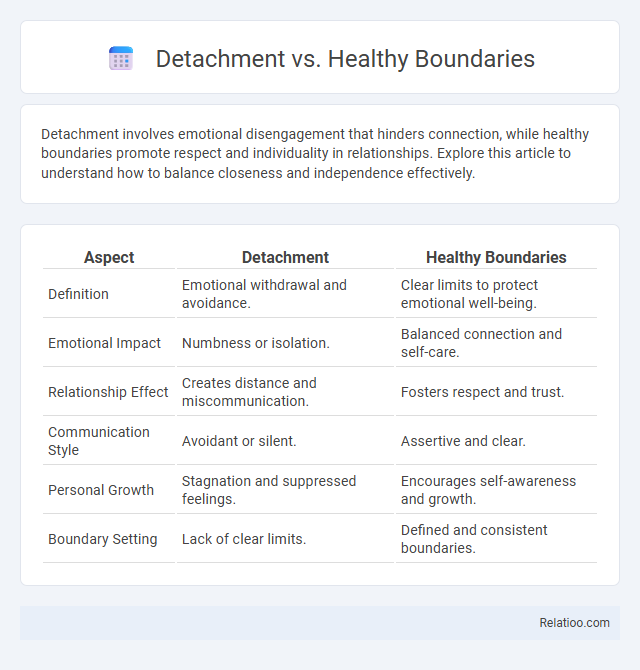Detachment involves emotional disengagement that hinders connection, while healthy boundaries promote respect and individuality in relationships. Explore this article to understand how to balance closeness and independence effectively.
Table of Comparison
| Aspect | Detachment | Healthy Boundaries |
|---|---|---|
| Definition | Emotional withdrawal and avoidance. | Clear limits to protect emotional well-being. |
| Emotional Impact | Numbness or isolation. | Balanced connection and self-care. |
| Relationship Effect | Creates distance and miscommunication. | Fosters respect and trust. |
| Communication Style | Avoidant or silent. | Assertive and clear. |
| Personal Growth | Stagnation and suppressed feelings. | Encourages self-awareness and growth. |
| Boundary Setting | Lack of clear limits. | Defined and consistent boundaries. |
Understanding Detachment and Healthy Boundaries
Understanding detachment involves recognizing emotional separation without disengagement, allowing you to maintain inner peace during challenging situations. Healthy boundaries define limits that protect your well-being while promoting respectful connections with others. Cultivating both detachment and healthy boundaries supports emotional resilience and balanced relationships.
Key Differences Between Detachment and Boundaries
Detachment involves emotionally distancing oneself to minimize personal involvement, often leading to withdrawal, whereas healthy boundaries establish clear limits that promote mutual respect and personal well-being in relationships. Boundaries define acceptable behaviors and protect individual autonomy without severing emotional connections, while detachment may result in emotional disconnection and isolation. The key difference lies in boundaries fostering connection through respect, whereas detachment prioritizes emotional separation for self-preservation.
The Psychology Behind Emotional Detachment
Emotional detachment involves a psychological defense mechanism where individuals distance themselves from feelings to avoid pain or vulnerability, often leading to numbness or disconnection. Healthy boundaries create a balanced emotional space, allowing people to maintain self-respect and autonomy while engaging empathetically with others. Unlike emotional detachment, healthy boundaries promote well-being by fostering clear limits without suppressing emotions or relationships.
What Are Healthy Boundaries in Relationships?
Healthy boundaries in relationships are essential for maintaining respect, trust, and emotional well-being by clearly defining personal limits and needs. Unlike detachment, which involves emotional withdrawal or disengagement, healthy boundaries allow you to stay connected while protecting your sense of self. Establishing these boundaries helps prevent codependency and fosters mutual understanding, ensuring both partners feel safe and valued.
Signs of Unhealthy Detachment
Signs of unhealthy detachment include emotional numbness, avoidance of meaningful relationships, and persistent feelings of isolation despite social interactions. This detachment often leads to difficulties in expressing emotions and an inability to form secure attachments, contrasting with healthy boundaries that promote balanced connections and self-respect. Recognizing these signs is crucial for addressing underlying issues like trauma, anxiety, or depression to foster emotional well-being.
Benefits of Setting Healthy Boundaries
Setting healthy boundaries fosters emotional resilience, enhances self-respect, and promotes balanced relationships. Unlike detachment, which may lead to emotional distance or disengagement, healthy boundaries allow you to protect your well-being while maintaining meaningful connections. Your mental clarity and stress reduction improve as a direct benefit of clear, consistent limits.
Common Misconceptions About Detachment
Common misconceptions about detachment often confuse it with emotional coldness or indifference, but true detachment involves maintaining inner peace while staying connected to your emotions and experiences. Unlike unhealthy detachment, which can lead to avoidance or suppression of feelings, healthy boundaries promote clear limits that protect your well-being without disconnecting you from others. Your ability to discern between these concepts ensures balanced relationships and emotional resilience.
How to Cultivate Healthy Boundaries Without Withdrawing
Cultivating healthy boundaries involves clear communication and self-awareness, allowing individuals to protect their emotional well-being without completely withdrawing from relationships. Unlike detachment, which often implies emotional distancing or avoidance, healthy boundaries maintain connection while fostering respect and trust. Practicing assertiveness and recognizing personal limits enable one to engage authentically without sacrificing inner peace or relational closeness.
The Impact on Mental Health: Detachment vs Boundaries
Detachment involves emotional withdrawal that can lead to feelings of isolation and increased anxiety, negatively affecting mental health. Healthy boundaries establish clear limits in relationships, promoting emotional safety and self-respect, which support mental well-being. Maintaining boundaries enhances resilience and reduces stress, while detachment often exacerbates emotional distress and disconnection.
Practical Steps for Developing Healthy Boundaries
Establishing healthy boundaries involves clear communication, recognizing your limits, and consistently enforcing them to protect your emotional well-being. You can start by identifying areas where you feel uncomfortable or overwhelmed, then assertively expressing your needs without guilt or apology. Practice self-awareness and reflection regularly to adjust boundaries as relationships evolve, fostering respect and mutual understanding.

Infographic: Detachment vs Healthy Boundaries
 relatioo.com
relatioo.com